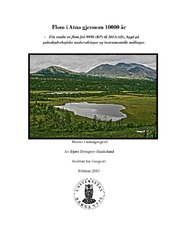| dc.description.abstract | Knowledge about past environmental extremes such as river floods, can help planners and politicians make better decisions for the future, and improve forecasting of future flood events. This paper presents a paleohydrological study of river floods in the Atna river, southeast Norway, near the mountains of Rondane. Atna is a tributary river to Glomma, the largest river in Norway. A 3 meter long sediment core (HTP108) was extracted from lacustrine sediments from the lake Hessetjørna. The core was analysed with multiple methods; CT-scan, loss on ignition and grain size, and through these and several other analyses 57 individual flood events was detected. 6 organic macro fossils was analysed and dated (AMS-C14) by Poznan radiocarbon laboratory. The macro fossils was dated from 8840 to 1380C14 years with one inverted result, and based on these dates an age model was made for the deposition of the sediments found in HTP108. The recurrence interval for floods the entire core is 175years, however the age model shows that the Atna catchment has experienced changing flood regimes. The most active flood periods are detected in: 9800-9580BP, 8380-7600BP and 5260-1200BP. The results carry some similarity with previous studies carried out in the region (Nesje et al. (2001), Bøe et al. (2006), Matthews et al. (2009) and Killingland (2009)), especially in the earliest and the latest period from 5260-1200BP. The floods that are found both in Hessetjørna and in the studies from other catchments are interpreted as being the largest floods due to a regional rather than a local spatial extent. Storofsen (1789AD) is the largest river flood ever detected in Norway, and it has also been detected in the Atna catchment by Nesje et al. (2001) and by a second river bed sediment core in this study (ARB108). However, the upper part of HTP108 where the inverted macro fossil was found, leads to the conclusion that there has been a large flood after 1300BP which has both eroded in Hessetjørna, and deposited the inverted macro fossil. The erosion has removed parts of the younger flood history. This is probably Storofsen, but this remains to be tested. Due to the erosion in the upper part of HTP108, and lack of C14dates above the eroded level, there is little evidence to link the flood layers detected in the upper part of the core with historical known or gauged floods. However, as there are to river gauging stations in Atna, with hourly records from 1916 and 1997 to present, a brief presentation of the gauged floods can be found in chapter 3. The gauging stations show that Atna has experienced 25 minor flood events (annual magnitude), 14 large floods (5-year recurrence interval), and 2 extreme floods (50-year recurrence interval) from 1916 to 20011. Of these floods both 50-year, and 2 of the 5-year floods can also be found at a flood gauge for Glomma at Elverum. This leads to that only the largest river flood events found in Atna is of a regional character, and that Atna like most other rivers more often experience floods that is of a local character. Of the 41 flood event found in Atna, only two occurs during late summer/early autumn and is solely caused by rainfall. This means that river floods in Atna catchment follows the typical pattern of inland Norway where floods are mainly snowmelt related. | en_US |
